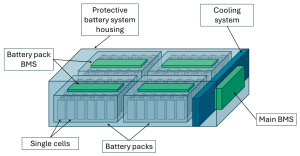Explanation of battery reserve capacity: duration of constant load
For those without extensive electrical experience, buying batteries can feel a little overwhelming. With all the different styles, sizes, and brands, it’s easy to raise your hand and buy the one recommended by others. But knowing your battery’s specifications can go a long way in finding the right battery. One specification you may have seen is battery reserve capacity. That’s why it’s so important to know about your next battery search.
What is battery reserve capacity
The battery reserve capacity is just the amount of time (in minutes) that a 12V lead acid battery can take a 25 amp load and stay above 10.5 volts.
When evaluating batteries, it is imperative to make sure buyers are comparing apples to apples. This is where battery reserve capacity (also known as RC) comes in. The longer a fully charged battery operates before falling below a certain voltage, the higher the battery reserve capacity. Most types of conventional lead-acid batteries show this measurement.
At high levels of reserve, capacity is a more accurate measure of how long a lead-acid battery will last under sustained load than its amp-hour rating. Due to the Peukert effect, this rating will be much lower than the actual capacity of the battery.

What do CCA and RC on a battery mean
RC stands for Reserve Capacity and is commonly found in deep cycle lead-acid batteries. It’s important to note that the reserve capacity measurements were made at 80 degrees Fahrenheit (the optimal temperature condition for the battery).
CCA is a completely different measurement method, specifically for vehicle launch applications. CCA stands for “Cold Crank Amplifier”. Contrary to battery reserve capacity, CCA is measured in amps rather than minutes. It shows how many amps the battery will deliver without dropping below 7.2 volts for 30 seconds at 0 degrees Fahrenheit. This is key information to know when starting your vehicle to ensure the engine is getting enough power from the battery to roll over in less than ideal conditions.
It is important to note that CCA has nothing to do with battery capacity and does not indicate whether the battery can be used for deep discharge. The starter battery is constructed very differently from deep cycling and is designed to be used for a brief burst of energy and then recharged immediately.
How is the reserve capacity calculated
Battery backup capacity measures time, so you’ll see it in minutes. To calculate the RC of a battery, the battery must first be fully charged. The manufacturer then draws 25 amps from the battery at 80 degrees Fahrenheit until it drops below 10.5 volts. The number of minutes it takes for this to happen is the battery’s spare capacity.
What is a high reserve battery
As the name suggests, a high-reserve battery is one that can provide an above-average reserve capacity. These batteries generally produce a lower but still usable charge, which means the total capacity will last longer.
These are useful for those who consistently use a lot of battery capacity between charges. They are also suitable for those who may not be using the battery for a long time. High-reserve batteries are more likely to retain some energy even after a period of inactivity. This helps avoid accidentally draining the battery.
Is battery reserve capacity the same as amp hours
No, these are separate measurements that reflect different things. On the one hand, reserve capacity is a simple measure of time, while amp-hours measure the number of amps a battery can deliver in an hour.
However, the two measurements are related and you can convert one to the other. Divide RC by 60, and then multiply this number by 25 to get amp hours. If you have amp hours, divide this number by 25, then multiply that number by 60 to find the battery backup capacity.
Keep in mind that this doesn’t exactly mean equal energies, as voltage is not considered for measurement and conversion.

Do lithium batteries have spare capacity
Yes, lithium-ion batteries have backup capacity, but they’re not usually rated or mentioned that way. For lithium batteries, ampere-hours or watt-hours are the norm.
Due to 25 amps and the Peukert effect, the backup capacity of lead acid batteries will be reduced. The Peukert effect shows how conventional lead-acid batteries decrease capacity as discharge rate increases. High quality lithium like our Maxworld Power series is not significantly affected by the Peukert effect, the amp hour rating of the battery is the actual amount of charge you can get from the battery in most situations.
There is another important thing to note about maximizing the battery reserve capacity level of a lead-acid battery. Achieving full RC will drop the battery voltage to 10.5 volts, below 50% of charge. If this level is reached on a regular basis, it will greatly shorten the life of lead-acid batteries. Therefore, think of RC as an upper limit rather than a target range.
While this is not a published number, you can say that our 100AH battery has a backup capacity of 240 minutes, even if the battery voltage never drops below 10.5 volts. The internal BMS will shut it down before that. It’s important to remember that Battle Born’s 240 minutes of consumption won’t damage the battery as it would with a lead-acid battery.
Conclusion:
RC is only relevant when looking at lead acid deep cycle batteries for long discharge situations. For engine starting applications, RC is of no benefit, while CCA is the more important measurement.
When choosing a battery, it’s important to know whether it can meet everyday needs and how far it can go in an emergency. Battery reserve capacity is one of the most valuable ways to quantify this with lead acid. While different manufacturers and types of batteries may each promise confusing or unclear benefits, RC makes it easy to make apples-to-apples comparisons.
While both CCA and RC numbers are only a small part of choosing the right battery (along with type, brand, size, and other considerations), understanding their role is critical.












